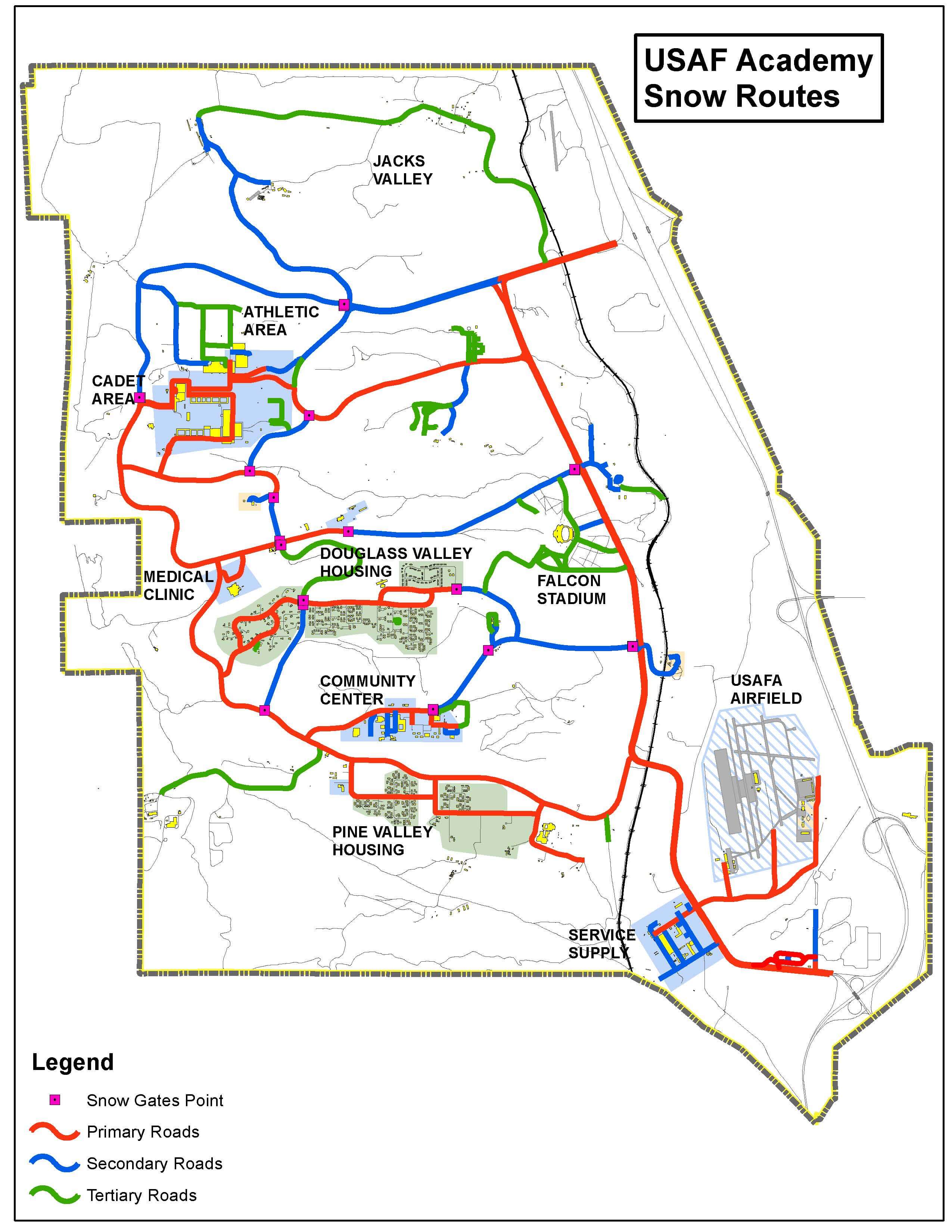Don’t be fooled: It’s time for winter safety

This year’s snow routes at the U.S. Air Force Academy are shown here. (10th Civil Engineering Squadron graphic)
By John Sutherland, Oct. 20, 2017
U.S. AIR FORCE ACADEMY, Colo. — Last year, more than 58 inches of snow fell on the Air Force Academy. We all need to be ready for winter as the Front Range weather can change quickly.
The most important element of safe winter driving is adjusting our driving habits to match the weather and road conditions. The No. 1 safety tip is to reduce your speed by at least 10 mph when road conditions are hazardous or your visibility is limited.
Snow route signs are installed throughout the base, indicating the main thoroughfares or “snow routes.” These routes won’t change except for a major construction project. In this case, snow route changes are announced via email and on the Academy’s social media platforms.
The snow route map shows the snow routes and snow gate locations on secondary roads. “Red” roads, for emergency access, are the primary snow routes and are open 24 hours-a day. “Blue” roads are the secondary routes. Overnight, these roads don’t receive the same attention as emergency access roads.
For safety reasons, snow gates at the entrance of secondary roads are not to be accessed when closed. Stay on the snow routes during and immediately after a snow event.
Delayed reporting or a base-closure is announced via radio and TV, so check your local station before heading to work.
If we have significant snowfall, the Academy will inform you of reporting times through the media. Late reporting, early release or a base closure, is designed for everyone’s safety. Automated closure or delay information, and road conditions, is available at 333-2800, the “Snow Call line.” Academy residents at other bases may follow reporting times for those installations.
Never assume you’re “mission essential” and report to work as an overabundance of traffic can be dangerous. Snow crews need time to clean-up our roads and sidewalks before we get to work.
Commander’s determine who is “mission essential,” so report as directed as communicate with them if you have safety concerns. The Main Exchange, Commissary and Army and Air Force Exchange Service will open at designated late reporting times. The Child Development Center will open at its normal time to accommodate the children of “mission-essential workers.”
Before inclement weather, snow crews may apply a liquid anti-icing chemical to prevent ice from sticking to the roads and sidewalks. The liquid may produce a temporary slippery effect. Before the morning rush hour, a granular chemical deicer is applied on hills, curves, stopping points and intersections.
Safety Tips
- Keep a windshield scraper and automotive snow brush in your vehicle.
- Keep a full tank of gas during winter. This limits condensation inside the fuel tank when it warms up.
- Make sure you vehicle’s tires have adequate tread-depth. Good all-season tires are worth the cost.
- Keep snack bars items, trail mix, MREs, foods with high calorie and high-protein food in your vehicle in case you’re stranded. Include candles, fire source like lighters and additional warm clothes, First aid kit, small camp shovel, road flares and a flashlight with extra batteries. Your cellphone is essential; try messaging if you have poor reception as this uses less energy from the phones battery and will often transmit while a call may not.
- Check the weather reports or call the Colorado Department of Transportation at 877-315-7623 for the latest road conditions. This information is updated hourly and will inform you major highways being treated for ice and snow removal. Another mobile website, cotrip.org, offers travel alerts for I-70, I-25 and other highways and roads throughout Colorado.
- Travel during daylight if possible and take at least one other person. Keep others informed of your travel schedule.
- Dress warmly. Wear loose‐fitting, layered and light‐weight clothing. Wet clothing loses its insulating value quickly and can accelerate hypothermia.
- Cold weather strains the heart. Shoveling snow or pushing a vehicle if you’re unaccustomed to exercising can cause a heart attack or make other medical conditions worse. Take frequent breaks when performing strenuous activities.
- Lookout for symptoms of frostbite and hypothermia
- Stay in your vehicle if stranded. Don’t search for assistance unless you see a building close and you can take shelter.
- Hang a brightly colored cloth on the radio antenna.
- Run the engine for about 10 minutes each hour to stay warm. Beware of carbon monoxide poisoning. Keep the exhaust pipe clear of snow and open a downwind window slightly for ventilation. Recharge your phone.